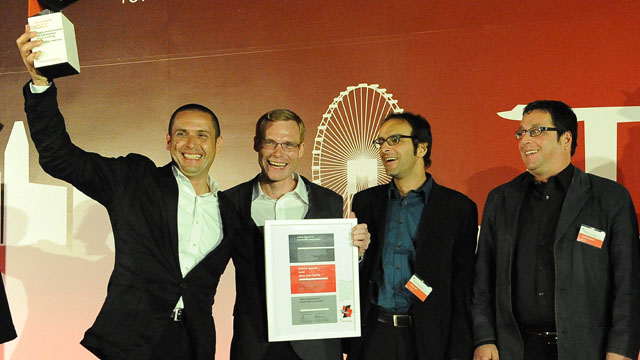December 9, 2011 8:00 AM CST
The Swiss-based Holcim Foundation for Sustainable Construction conducts the Holcim Awards competition to promote sustainable responses to contemporary technological, environmental, socioeconomic and cultural issues from the building and construction. More than 6,000 submissions for projects located in 146 countries entered the competition with a total prize sum of USD 2 million per three-year cycle.
Wowo Ding, Head of jury and Dean of Architecture at Nanjing University, China, praised the project for propagating the use of new construction methods by the agrarian population and improving the local economic situation. “The new construction approach shows the rural community an affordable, high quality and durable alternative compared to widely-used but higher cost and less environmentally-compatible construction materials,” she said.
A primary healthcare center, near Dharmapuri, in a hot and semi-arid rural region in Andhra Pradesh, India designed by Rajesh Renganathan and Iype Vernperampil of Flying Elephant Studio provides a shaded and well-ventilated waiting and gathering space together with a high-tech medical core. An urban renewal and transport circuit designed by Madhav Raman and Vaibhav Dimri of Anagram Architects converts an under-utilized ring railway into a multi-use civic and traffic space within the urban fabric of New Delhi to support the vibrant street life which is an integral part of Indian culture. A post-earthquake housing renovation project in Kobe, Japan by Masaaki Takeuchi of uzulab and Shihoko Koike of Osaka City University upgrades an existing concrete structure using simple means to include a ground-floor retail facility, outdoor gardens, and extensively vegetated exterior structures forming an ameliorated urban space.
The Holcim Awards seeks innovative, future-oriented and tangible sustainable construction projects and is run in cooperation with renowned partner universities: Swiss Federal Institute of Technology (ETH Zurich), Switzerland; Massachusetts Institute of Technology (MIT) in Cambridge, Massachusetts, USA; Universidad Iberoamericana (UIA) in Mexico City, Mexico; École Supérieure d’Architecture de Casablanca (EAC), Morocco; Indian Institute of Technology (IIT Bombay) in Mumbai, India; Tongji University (TJU) in Shanghai, China; Universidade de São Paulo (USP), Brazil; and the University of the Witwatersrand (Wits) in Johannesburg, South Africa.
The Holcim Foundation is supported by Holcim Ltd and its Group companies in more than 70 countries and is independent of its commercial interests. Holcim is one of the world’s leading suppliers of cement and aggregates (crushed stone, gravel and sand) as well as further activities such as ready-mix concrete and asphalt, including services.
Holcim Awards winners for Asia Pacific announced
Innovative architecture focused on infrastructure for communities

Winners of the Holcim Awards Gold 2011 Asia Pacific for “Locally-manufactured cob and bamboo school building, Jar Maulwi, Pakistan” (l-r): Eike Roswag, Ziegert Roswag Seiler Architekten Ingenieure, Germany, Arne Tönissen, Akim Jah and Karim Jah.
Winners of the Holcim Awards for sustainable construction projects and visions from Asia Pacific have been announced, bringing the regional phase of the 3rd International Holcim Awards competition to a close. A total of USD 300,000 was presented to twelve groundbreaking projects at a ceremony in Singapore. The winning projects show how sustainable approaches to infrastructure for communities and innovative architecture can improve the built environment and enhance quality of life.The Swiss-based Holcim Foundation for Sustainable Construction conducts the Holcim Awards competition to promote sustainable responses to contemporary technological, environmental, socioeconomic and cultural issues from the building and construction. More than 6,000 submissions for projects located in 146 countries entered the competition with a total prize sum of USD 2 million per three-year cycle.
Holcim Awards Gold to a locally-manufactured cob and bamboo school building in Pakistan
A project that upgrades a traditional building method with effective low-tech measures through engineering and design won the top prize of USD 100,000 in Asia Pacific. The Earthen School Tipu Sultan Merkez, in a small village near Lahore, Pakistan and designed by architect Eike Roswag of Ziegert Roswag Seiler Architekten Ingenieure in Germany, provides seven new classrooms in a school for underprivileged girls. The building is constructed from a locally-sourced cob (clay, sand, water, and straw) lower-floor combined with an upper floor made of earth-filled bamboo walls. Intense research on cob construction resulted in a significant increase in strength and durability, and extended maintenance intervals compared to traditional approaches.Wowo Ding, Head of jury and Dean of Architecture at Nanjing University, China, praised the project for propagating the use of new construction methods by the agrarian population and improving the local economic situation. “The new construction approach shows the rural community an affordable, high quality and durable alternative compared to widely-used but higher cost and less environmentally-compatible construction materials,” she said.
Silver for a factory conversion to urban agriculture in Thailand
The Holcim Awards Silver was presented to a Thai project team led by Isavaret Tamonut of TTH Trading for the conversion of a former textile factory and adjacent land into a 1.4ha agricultural production site and retail outlet. The Urban Farm Urban Barn is located in a mixed use urban zone of central Bangkok and reintroduces elements of self-sufficiency while also reconnecting food production and consumption. The project was applauded by the jury for its potential to create a new urban culture, re-sensitizing the community to its ecological impacts and offering a new perception of urbanity that is readily transferrable.Ecologically-designed retail and commercial building in Malaysia wins Bronze Award
The Holcim Awards Bronze was awarded to a team led by architect Ken Yeang of T R Hamzah & Yeang International for a 14-level commercial and retail building located in Malaysia’s federal administrative city of Putrajaya. The building brings together state-of-the-art technologies appropriate for high-quality use in two interconnected towers that use vegetation to actively reduce energy consumption, provide solar shading, and create comfortable spaces considering all requirements of utilization. The jury commended the project for its imaginative and leading-edge response to upmarket building design that uses integrative engineering to create a sustainable building organism, showcasing best practice design.Projects in Indonesia, India and Japan receive Acknowledgements
Six projects were presented with an Acknowledgement prize – three are located in Indonesia, two in India and one in Japan. A project in three villages of Central and West Java led by Yandi Yatmo of Universitas Indonesia uses the process of building to encourage community consolidation and development. A socially-integrated rural school in Sukoharjo by Dian Susilo of deesignhandmade includes school functions, agricultural areas and a marketplace that involves the local community to share in the benefits of the school infrastructure. The vertical informal settlement designed by a team led by Steven Brunsmann of nunc architects in the Netherlands provides a housing strategy for informal settlements in Jakarta that alleviates problems from flooding, promotes waste recycling, maintains social coherence and provides affordable living spaces.A primary healthcare center, near Dharmapuri, in a hot and semi-arid rural region in Andhra Pradesh, India designed by Rajesh Renganathan and Iype Vernperampil of Flying Elephant Studio provides a shaded and well-ventilated waiting and gathering space together with a high-tech medical core. An urban renewal and transport circuit designed by Madhav Raman and Vaibhav Dimri of Anagram Architects converts an under-utilized ring railway into a multi-use civic and traffic space within the urban fabric of New Delhi to support the vibrant street life which is an integral part of Indian culture. A post-earthquake housing renovation project in Kobe, Japan by Masaaki Takeuchi of uzulab and Shihoko Koike of Osaka City University upgrades an existing concrete structure using simple means to include a ground-floor retail facility, outdoor gardens, and extensively vegetated exterior structures forming an ameliorated urban space.
“Next Generation” prizes for post-graduate student visions
The Holcim Awards competition recognizes the importance of engaging tomorrow’s professionals on the theme of sustainable construction through the “Next Generation” category which shares the visions and ideas of postgraduate university students. First prize was awarded to August Liau, Massachusetts Institute of Technology (MIT), United States for a project to increase bicycle commuting in Beijing, China. The project advocates pedal power as a dynamic alternative for urban transit and recalls its well-proven potential in the world’s former cycling capital. Second prize was awarded to Indian student Mishkat Ahmed, University of California, Berkeley, United States for an approach to town planning that introduces focus and context-sensitivity into large scale urban planning for the revitalization and urban development of Navi Mumbai. Julia King, London Metropolitan University, United Kingdom received the third prize for a sound research approach that leads to a practical solution for an urgent problem by providing a decentralized sanitation system in Savda Gehvra, a regulated resettlement suburb 30km west of New Delhi, India.Independent jury of international experts in architecture and sustainability
Holcim Awards submissions for projects in Asia Pacific were evaluated by an independent jury hosted by the Indian Institute of Technology (IIT Bombay), in Mumbai: Wowo Ding (Head, China), Uday Athavankar (India), Olivia la O’ Castillo (Philippines), Paul Hugentobler (Switzerland), Momoyo Kaijima (Japan), Ashok B Lall (India), Valérie Portefaix (China), Hans-Rudolf Schalcher (Switzerland), and Gunawan Tjahjono (Indonesia) used the five “target issues” for sustainable construction developed by the Holcim Foundation to evaluate submissions. The “target issues” address the triple bottom line of economic, environmental, and social factors together with architectural quality and the potential to apply the innovation in other locations.Conclusion to a series of five Holcim Awards ceremonies
The Holcim Awards ceremony for Asia Pacific in Singapore concluded the series of five events and followed the presentation of winners in Casablanca, Milan, Buenos Aires and Washington, DC. The projects that received Holcim Awards Gold, Silver and Bronze in each region are automatically qualified for the Global Holcim Awards 2012. In addition, all prize-winning projects at the regional level – including the Acknowledgement and “Next Generation” winners – will automatically compete for Global Holcim Innovation prizes. Winners of the global prizes will be announced in April 2012.The Holcim Awards seeks innovative, future-oriented and tangible sustainable construction projects and is run in cooperation with renowned partner universities: Swiss Federal Institute of Technology (ETH Zurich), Switzerland; Massachusetts Institute of Technology (MIT) in Cambridge, Massachusetts, USA; Universidad Iberoamericana (UIA) in Mexico City, Mexico; École Supérieure d’Architecture de Casablanca (EAC), Morocco; Indian Institute of Technology (IIT Bombay) in Mumbai, India; Tongji University (TJU) in Shanghai, China; Universidade de São Paulo (USP), Brazil; and the University of the Witwatersrand (Wits) in Johannesburg, South Africa.
The Holcim Foundation is supported by Holcim Ltd and its Group companies in more than 70 countries and is independent of its commercial interests. Holcim is one of the world’s leading suppliers of cement and aggregates (crushed stone, gravel and sand) as well as further activities such as ready-mix concrete and asphalt, including services.
About the Author
Holcim (US), Inc. is a subsidiary of Holcim Ltd, and one of the nation’s leading manufacturers and suppliers of cement and mineral components. Holcim (US) has approximately 2,000 employees and operates 13 manufacturing plants and 70 distribution facilities in the United States. For more information about Holcim (US), Inc. visit www.holcim.us.


















